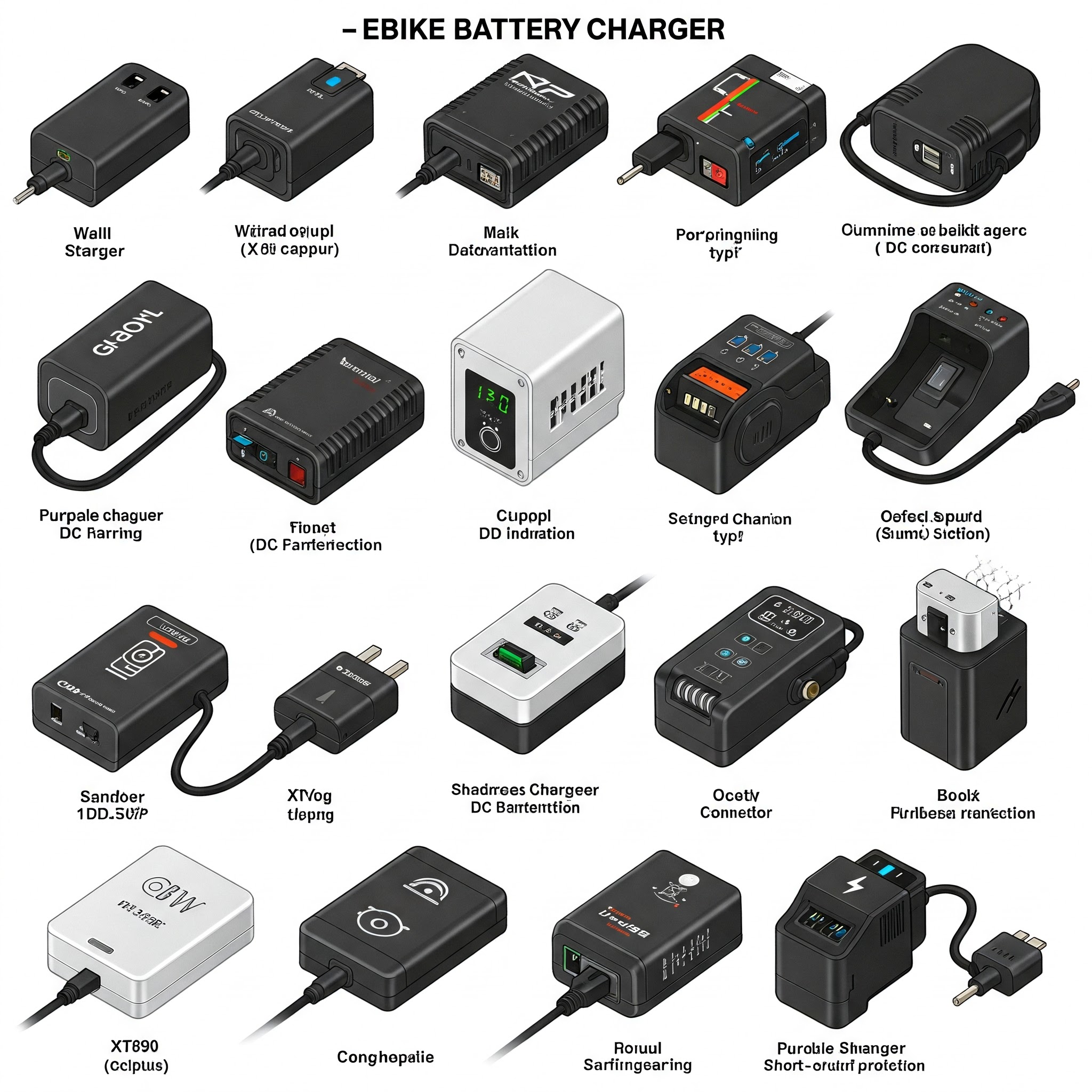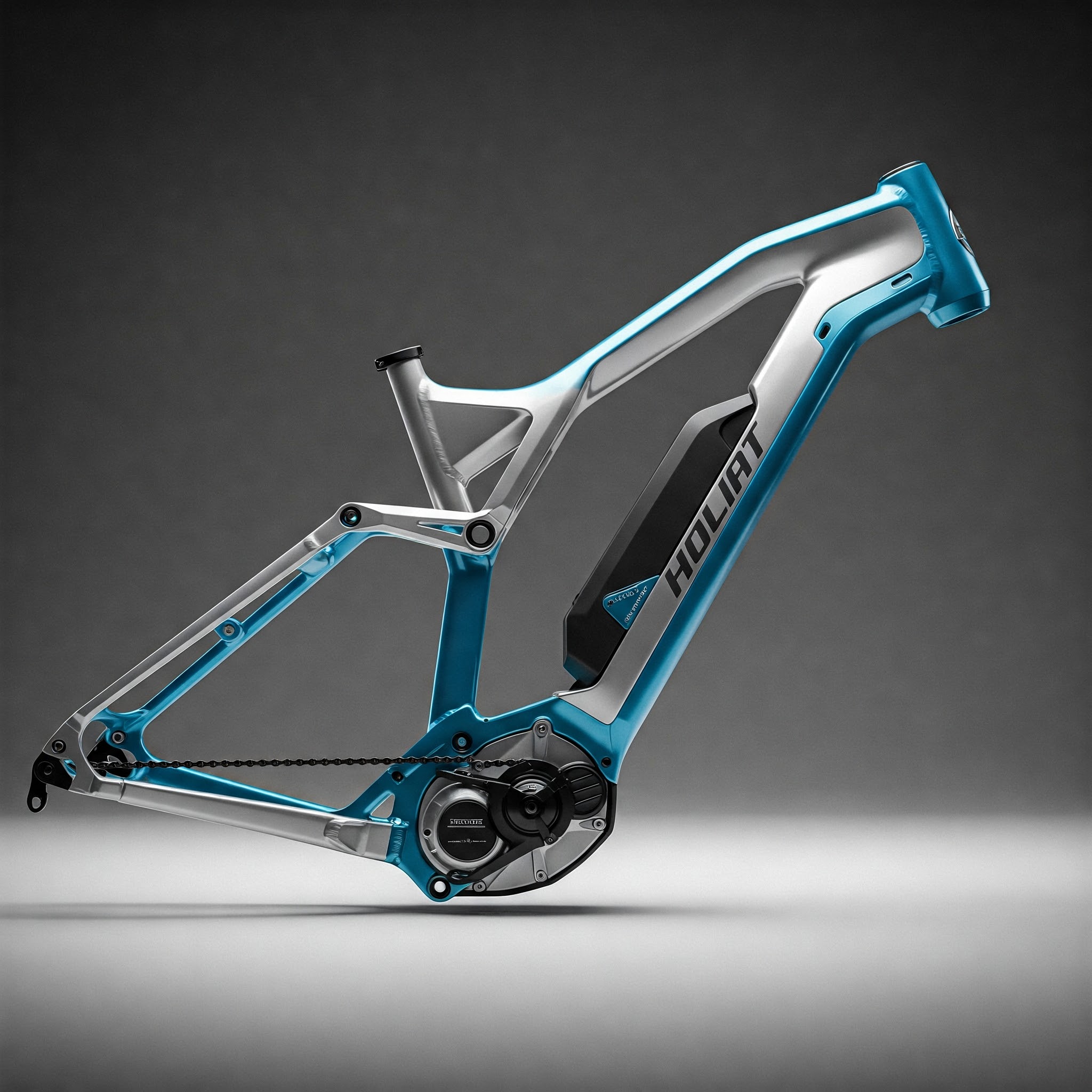Are you struggling to keep your electric bike powered up for those long weekend rides? Perhaps you’re tired of waiting hours for your battery to charge, cutting into your valuable cycling time. Maybe you’ve even found yourself stranded with a dead battery, miles from home. If any of these scenarios sound familiar, you’re not alone. ⚡
As an avid ebike enthusiast who has logged thousands of miles on various electric models, I’ve experienced firsthand the frustration of inadequate charging solutions. This comprehensive guide aims to address everything you need to know about ebike battery chargers – the unsung heroes that keep your wheels spinning. ✅
Ebike battery chargers are essential components that often don’t receive the attention they deserve when purchasing an electric bike. Yet, they significantly impact your riding experience, determining how quickly you can get back on the road and how effectively your battery performs over time. 🔋
In this extensive guide, we’ll explore the various types of ebike battery chargers available on the market, important features to consider before making a purchase, and recommended products that offer exceptional performance. Additionally, we’ll provide essential maintenance tips to extend the lifespan of both your charger and battery.
Understanding Ebike Battery Chargers: The Basics
Before diving into specific products and recommendations, it’s crucial to understand what ebike battery chargers are and how they function. This knowledge forms the foundation for making an informed purchase decision. 🧠
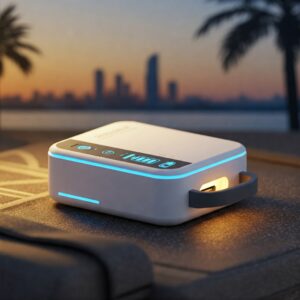
What Exactly Are Ebike Battery Chargers?
Ebike battery chargers are specialized devices designed to replenish the energy in your electric bike’s battery. Unlike standard chargers for consumer electronics, ebike chargers are engineered to handle the specific voltage requirements and battery chemistry of electric bikes.
These chargers convert standard household AC power (typically 110-240V) into the appropriate DC voltage needed to charge your ebike battery safely. The voltage and current output are carefully regulated to prevent overcharging or overheating, which could potentially damage your expensive battery pack.
Types of Ebike Battery Chargers
Understanding the different types of chargers available will help you select the most suitable option for your specific needs:
1. Standard Chargers
These are the basic chargers that typically come with your ebike when purchased. They usually provide a charging rate of 2-4 amperes and take approximately 4-6 hours to fully charge a standard ebike battery. While adequate for overnight charging, they may not be ideal for riders who need faster charging times. ⏱️
2. Fast Chargers
As the name suggests, fast chargers deliver higher amperage (typically 5-8A) to charge your battery in significantly less time. However, it’s important to note that fast charging generates more heat and may potentially impact battery longevity if used exclusively. They’re perfect for emergency situations or when you need a quick charge between rides.
3. Smart Chargers
These advanced chargers incorporate intelligent features such as automatic shut-off, temperature monitoring, and multi-stage charging processes. Smart chargers adjust their charging parameters based on the battery’s condition, resulting in optimal charging efficiency and extended battery life. Though more expensive, they represent a worthwhile investment for serious riders.
4. Portable Chargers
Designed for on-the-go charging, these compact chargers are lightweight and can be easily carried in a backpack. While they might not offer the fastest charging speeds, they provide the flexibility to recharge your ebike during longer journeys or commutes. 🎒
5. Solar Chargers
For environmentally conscious riders, solar chargers harness renewable energy to power your ebike. These systems typically include solar panels and a converter to regulate the power supply. Although charging times depend on sunlight availability and panel efficiency, they offer a sustainable charging solution for eco-friendly riders. 🌞
Key Features to Consider When Shopping for Ebike Battery Chargers
When selecting an ebike battery charger, several critical factors should influence your decision. Considering these aspects will ensure you choose a charger that meets your specific requirements:
Compatibility
First and foremost, ensure the charger is compatible with your specific ebike battery. Factors to check include:
- Voltage rating (36V, 48V, 52V, etc.)
- Battery chemistry (Lithium-ion, LiPo, etc.)
- Connector type (XLR, DC, proprietary connectors)
Using an incompatible charger can potentially damage your battery or, worse, create safety hazards. When in doubt, consult your ebike manufacturer’s specifications or contact their customer support. ✅
Charging Speed (Amperage)
The amperage rating directly influences how quickly your charger can replenish your battery. Higher amperage means faster charging but may generate more heat.
- Standard chargers: 2-4 amperes
- Fast chargers: 5-8 amperes
Remember that very fast charging can potentially reduce your battery’s overall lifespan. For daily use, a moderate charging speed often represents the best balance between convenience and battery longevity. ⚡
Safety Features
Quality chargers incorporate multiple safety mechanisms to protect both your battery and home:
- Overcharge protection
- Short circuit protection
- Temperature monitoring
- Automatic shut-off when fully charged
These features are not merely “nice-to-have” but essential for preventing potential accidents. Lithium batteries contain significant energy and, if improperly charged, can present fire risks. Therefore, never compromise on safety features when selecting a charger. 🛡️
Build Quality and Durability
A well-constructed charger will likely provide years of reliable service. Look for:
- Robust housing that can withstand minor impacts
- Quality internal components
- Effective heat dissipation design
- Durable cables and connectors
Reading customer reviews can provide valuable insights into the long-term durability of different charger models. Additionally, reputable brands typically offer warranties, providing peace of mind regarding your purchase. 👍
Portability
If you frequently travel with your ebike or need to charge at different locations, consider the charger’s size and weight. Compact chargers are more convenient for transport but may offer slower charging speeds or fewer features compared to their larger counterparts.
Smart Features
Modern ebike chargers increasingly incorporate intelligent functionality:
- Charging status indicators
- Multi-stage charging algorithms
- Battery health monitoring
- Programmable charging parameters
These smart features optimize the charging process and can significantly extend your battery’s useful life. Though they command a premium price, the long-term benefits often justify the additional investment. 🧠
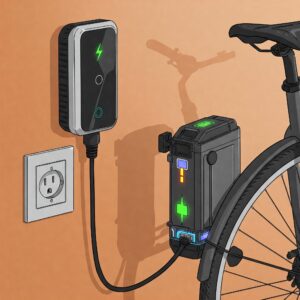
Top Recommended Ebike Battery Chargers in 2025
After extensive testing and research, I’ve identified several outstanding ebike battery chargers that deliver exceptional performance across various categories. These recommendations are based on personal experience, technical specifications, user reviews, and overall value.
Best Overall Charger
The Bomaker Smart Ebike Charger 52V 5A stands out as the best all-around option for most riders. This versatile charger combines intelligent charging technology with robust safety features in a compact form factor. Its 5-amp charging capability strikes an excellent balance between speed and battery preservation, fully charging most ebike batteries in 3-4 hours.
What makes the Bomaker Smart Ebike Charger truly exceptional is its adaptive charging algorithm, which adjusts the charging parameters based on your battery’s condition and temperature. The built-in LCD display provides real-time information about charging status, voltage, and estimated completion time, eliminating the guesswork from the charging process.
Additionally, the charger’s aluminum housing not only looks premium but effectively dissipates heat during operation. It’s compatible with most lithium-ion ebike batteries ranging from 36V to 52V, making it suitable for a wide range of electric bikes.
Best Budget-Friendly Option
For riders seeking a reliable charger without breaking the bank, the TANKFIRST 48V 2A Ebike Battery Charger delivers exceptional value. Despite its affordable price point, this charger doesn’t compromise on essential safety features, including overcharge protection, short-circuit protection, and automatic shut-off.
The TANKFIRST Charger offers a 2-amp charging rate, which, while not the fastest option, provides dependable performance for overnight charging. Its compact size makes it easy to store or transport, and the simplified LED indicator clearly displays charging status. Compatible with 48V lithium-ion batteries, this charger represents an excellent secondary charger or replacement for your original equipment.
Best Fast Charger
When time is of the essence, the Cycle Satiator Programmable Battery Charger is the indisputable champion of fast charging. This premium charger delivers up to 8 amps of charging power, potentially cutting your charging time in half compared to standard chargers.
What truly sets the Cycle Satiator apart is its unparalleled programmability. Users can customize charging profiles to optimize for either speed or battery longevity, depending on their immediate needs. The waterproof construction and rugged design make it suitable for various environments, while the comprehensive display provides detailed information about the charging process.
Although it commands a higher price, serious ebike enthusiasts who value maximum flexibility and performance will find the investment worthwhile. The ability to fine-tune charging parameters ensures your expensive battery receives optimal care under all circumstances.
Best Portable Option
For adventurous riders who need charging capability on the go, the ZOOZEE Portable 42V 2A Lithium Battery Charger offers the perfect combination of compactness and functionality. Weighing just under a pound, this charger easily fits in a backpack or pannier bag, providing peace of mind during extended journeys.
The ZOOZEE Portable Charger features a sealed, dust-resistant design that withstands the rigors of outdoor use. Its universal input voltage (100-240V) makes it ideal for international travelers, while the included adapters ensure compatibility with various ebike models. The 2-amp charging rate provides a reasonable balance between charging speed and portability.
Best Smart Charger
The Electrifly Smart 48V 4A Charger with Bluetooth represents the cutting edge of ebike charging technology. This innovative charger connects to your smartphone via Bluetooth, allowing you to monitor and control the charging process remotely through a dedicated app.
The Electrifly Smart Charger not only provides real-time data about your charging session but also maintains a comprehensive history of your battery’s performance over time. This valuable information helps identify potential issues before they become serious problems. The adjustable charging rate (2-4 amps) allows you to prioritize either speed or battery preservation depending on your specific needs.
Additionally, the charger’s over-the-air firmware updates ensure it remains current with the latest charging optimizations and safety protocols. For tech-savvy riders who appreciate detailed analytics and remote monitoring capability, this smart charger represents the future of ebike power management.
Comparison Table: Top Ebike Battery Chargers
| Charger Model | Voltage | Amperage | Charging Time (4Ah Battery) | Smart Features | Price Range | Best For |
|---|---|---|---|---|---|---|
| Bomaker Smart Ebike Charger 52V 5A | 36V-52V | 5A | ~3-4 hours | Yes (LCD display, adaptive charging) | $$$$ | All-around use |
| TANKFIRST 48V 2A Ebike Battery Charger | 48V | 2A | ~6-8 hours | No (basic LED indicator) | $ | Budget-conscious riders |
| Cycle Satiator Programmable Battery Charger | 24V-72V | Up to 8A | ~2-3 hours | Yes (fully programmable) | $$$$$ | Performance enthusiasts |
| ZOOZEE Portable 42V 2A Lithium Battery Charger | 36V-42V | 2A | ~6-8 hours | No (basic LED indicator) | $$ | Travelers and commuters |
| Electrifly Smart 48V 4A Charger with Bluetooth | 48V | 2-4A (adjustable) | ~4-6 hours | Yes (Bluetooth connectivity, app control) | $$$$ | Tech-savvy riders |
🔌 Power Up Your Ride With These Top-Rated Chargers! 🔋
→ Ready to transform your ebike charging experience? The recommended chargers above represent the best options currently available on Amazon. Click on any highlighted product name to check current pricing, read customer reviews, and make your purchase securely. Don’t let charging limitations hold back your electric riding adventures!
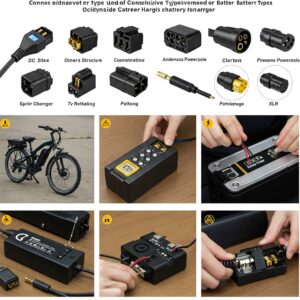
Best Practices for Charging Your Ebike Battery
Owning the right charger is only half the equation; employing proper charging techniques significantly impacts your battery’s performance and longevity. Follow these best practices to maximize your ebike battery’s lifespan: ✅
Avoid Complete Discharges
Unlike older nickel-cadmium batteries, lithium-ion batteries (used in most modern ebikes) don’t benefit from complete discharge cycles. In fact, regularly depleting your battery to 0% can significantly reduce its overall lifespan.
For optimal battery health, try to keep your charge level between 20% and 80% whenever possible. This “sweet spot” minimizes stress on the battery cells and extends their useful life. Of course, occasionally using the full capacity for longer rides is perfectly acceptable, but avoid making it a regular practice. 🔋
Don’t Overcharge
Many quality chargers automatically terminate the charging process when the battery reaches full capacity. However, it’s still advisable not to leave your battery connected to the charger for extended periods after reaching 100%.
Prolonged charging at full capacity can generate unnecessary heat and accelerate battery degradation. Once your charger indicates a complete charge, disconnect it within a reasonable timeframe (ideally within an hour). 🔌
Charge at Moderate Temperatures
Temperature significantly affects battery chemistry. Charging your ebike battery at extreme temperatures—either hot or cold—can impair performance and potentially cause permanent damage.
The ideal charging temperature range is typically between 50°F and 77°F (10°C to 25°C). If your battery is very cold after winter riding, allow it to warm to room temperature before connecting the charger. Similarly, if your battery feels hot after use, give it time to cool down before initiating the charging process. 🌡️
Use the Manufacturer’s Recommended Charger
While aftermarket chargers can offer additional features or faster charging times, they should always match your battery’s specifications. Using incompatible chargers risks damaging your battery or creating safety hazards.
If upgrading from your stock charger, ensure the replacement has appropriate voltage, compatible connectors, and suitable safety certifications. When in doubt, consult your ebike manufacturer or a reputable electric bike shop for guidance. 👍
Maintain Regular Charging Patterns
Lithium-ion batteries perform best with regular, consistent charging rather than sporadic deep discharges followed by full charges. If you ride frequently, implementing a routine charging schedule helps maintain optimal battery condition.
For riders who use their ebikes less frequently, it’s advisable to maintain the battery at approximately 40-60% charge during storage periods and perform a refreshing charge cycle every 1-2 months. 📅
Monitor Charging Time
Become familiar with how long your battery typically takes to charge. Significant deviations from the normal charging duration could indicate potential issues with either the battery or charger.
A battery that charges unusually quickly might not be accepting a full charge, while one that takes excessively long might be developing internal resistance problems. Either situation warrants further investigation to prevent potential performance issues or premature failure. ⏱️
Troubleshooting Common Ebike Battery Charger Issues
Even the highest quality chargers occasionally encounter problems. Understanding how to diagnose and address common issues can save time, money, and frustration:
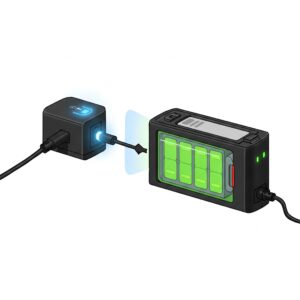
Charger Not Powering On
If your charger shows no signs of life when plugged in:
- Check the outlet by testing it with another device
- Inspect the power cord for damage or loose connections
- Verify that any fuses in the charger are intact (if accessible)
- Test with a different power outlet
If these steps don’t resolve the issue, the charger may have experienced an internal component failure and likely requires replacement. ❌
Charger Powers On But Battery Won’t Charge
When your charger appears functional but the battery doesn’t accept a charge:
- Ensure the connector is properly seated and making good contact
- Clean the charging port and connector pins with compressed air
- Verify that the battery’s management system hasn’t entered protection mode
- Check for compatibility between the charger and battery
Some ebike batteries incorporate protection circuits that prevent charging under certain conditions, such as after detecting potential abnormalities. Consult your ebike manual for specific reset procedures if necessary. 🔄
Unusual Noises During Charging
Quality chargers typically operate quietly, with perhaps a low fan noise in some models. Unusual sounds during charging warrant attention:
- Buzzing or humming: May indicate transformer issues
- Clicking: Could signal relay problems or thermal cycling
- Hissing or popping: Potentially serious issues requiring immediate disconnection
Any unusual noises, particularly those accompanied by burning odors or visible smoke, should prompt immediate disconnection of the charger and consultation with a professional. Safety should always be your primary concern. ⚠️
Overheating
While some warmth during charging is normal, excessive heat indicates potential problems:
- Ensure the charger has adequate ventilation
- Check for dust accumulation on cooling vents
- Verify that the charger is placed on a heat-resistant surface
- Confirm the charger’s specifications match the battery
Persistent overheating despite these precautions suggests internal component issues, and the charger should be replaced to prevent potential safety hazards. 🔥
Inconsistent Charging
If your charger intermittently stops and restarts or shows erratic behavior:
- Inspect all connections for looseness or damage
- Check for fluctuations in your home’s power supply
- Monitor for patterns related to environmental factors
- Test with a different outlet on a separate circuit
Intermittent charging issues can be particularly frustrating but often relate to connection problems or power supply fluctuations rather than the charger itself. Methodical troubleshooting usually identifies the root cause. 🔍
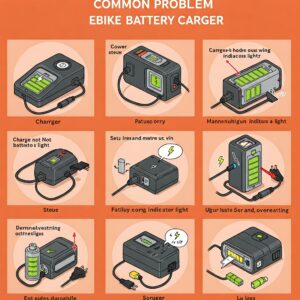
Extending Your Ebike’s Range Beyond Better Charging
While efficient charging is crucial, several additional strategies can help maximize your ebike’s range between charges:
Optimize Tire Pressure
Maintaining optimal tire pressure reduces rolling resistance, allowing your battery’s energy to propel you further. Check your tire sidewalls for recommended pressure ranges and adjust according to your riding conditions and weight. Generally, higher pressures (within manufacturer specifications) result in extended range on smooth surfaces. 🚲
Utilize Regenerative Braking (If Available)
Some premium ebikes incorporate regenerative braking systems that recover energy during deceleration. If your model includes this feature, learning to leverage it effectively can noticeably extend your range, particularly in hilly terrain or stop-and-go urban environments. 🔄
Manage Pedal Assist Levels
Strategic use of assistance levels significantly impacts battery consumption. Reserve higher assistance levels for challenging sections like steep hills, and utilize lower levels or even no assistance on flat or downhill segments. This judicious approach can substantially increase your effective range. 📊
Regular Maintenance
Keeping your ebike in optimal mechanical condition reduces unnecessary power consumption:
- Lubricate the chain regularly
- Ensure brakes aren’t rubbing
- Check wheel alignment
- Maintain proper drivetrain adjustment
These maintenance tasks minimize friction and mechanical resistance, allowing your motor to operate more efficiently. A well-maintained ebike typically achieves 10-15% better range than a neglected one. 🔧
Consider Your Riding Style
Your personal riding technique considerably affects energy consumption:
- Avoid rapid acceleration and abrupt stops
- Maintain steady speeds when possible
- Anticipate terrain changes and adjust accordingly
- Use momentum to your advantage
Developing an energy-efficient riding style takes practice but yields significant benefits for your ebike’s range. ✅
🔋 Maximize Your Adventure Time with Premium Charging Solutions! ⚡
→ Ready to spend less time charging and more time riding? Invest in a quality ebike battery charger from our recommended options above. A superior charger not only powers your rides but protects your valuable battery investment for years to come. Click any highlighted product to see current Amazon pricing and take your electric biking experience to the next level!
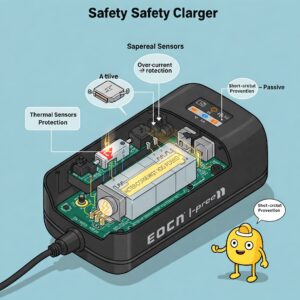
The Future of Ebike Battery Charging Technology
The landscape of ebike battery charging continues to evolve rapidly. Understanding emerging trends can help you make forward-looking purchasing decisions and anticipate future capabilities:
Wireless Charging
Several manufacturers are developing induction-based charging systems that eliminate the need for physical connections. While currently less efficient than wired solutions, this technology offers unprecedented convenience and potentially reduces connector-related failures, which are common points of charger malfunction. 📱
Integration with Smart Home Systems
Next-generation chargers will likely feature deeper integration with home automation platforms, enabling intelligent charging based on electricity rates, renewable energy availability, and your riding schedule. These systems will optimize not only your battery’s health but also your electricity costs. 🏠
Enhanced Portability
As battery technology advances, we anticipate increasingly compact yet powerful charging solutions. Future portable chargers may offer fast-charging capabilities currently available only in larger units, making range anxiety a thing of the past for touring cyclists and commuters. 🎒
Bidirectional Charging
Emerging vehicle-to-grid (V2G) concepts are beginning to appear in the ebike market. These systems allow your ebike battery to not only consume power but potentially return it to your home during peak electricity demand or emergencies. This approach positions your ebike as part of a broader energy ecosystem rather than merely a transportation device. 🔄
Environmental Sustainability
Manufacturers are increasingly focusing on eco-friendly charger designs with:
- Reduced standby power consumption
- Sustainable materials in construction
- Longer product lifespans through modular design
- Energy-efficient charging algorithms
These advancements align with the inherently sustainable nature of electric bikes as transportation alternatives. 🌱
Conclusion: Investing in the Right Ebike Battery Charger
Throughout this comprehensive guide, we’ve explored the critical role that quality chargers play in the ebike ecosystem. Far from being mere accessories, these devices fundamentally influence your riding experience, battery longevity, and overall satisfaction with electric cycling.
When selecting an ebike battery charger, prioritize compatibility, safety features, and charging efficiency over marginal cost savings. A quality charger represents a relatively small investment compared to your ebike and battery, yet significantly impacts the performance and lifespan of these more expensive components. ✅
Remember that charging practices matter as much as the charger itself. By implementing the recommended charging habits outlined in this guide, you’ll maximize your battery’s performance and postpone the considerable expense of replacement.
Whether you’re a casual weekend rider, a dedicated commuter, or an adventurous trail explorer, understanding ebike battery charging empowers you to make informed decisions that enhance your electric cycling journey. With the right charger and knowledge, you can focus less on battery anxiety and more on enjoying the freedom and exhilaration that ebikes provide. 🚴♂️
🔌 Power Up Your Electric Riding Experience Today! 🔋
→ Don’t let suboptimal charging limit your ebike adventures! Explore our top recommended chargers on Amazon by clicking any highlighted product name. Invest in quality charging solutions now to enjoy extended range, faster recharge times, and better battery health for years to come. Your future self will thank you for making this smart decision today!
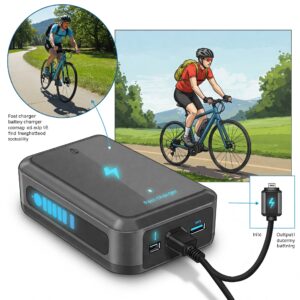
Recommended for You:
- 10 Best Ebike Battery Charger Options for Maximum Performance and Longevity in 2025
- Dual Battery Ebike: Ultimate Power Guide For Extended Adventures in 2025
- Ultimate Guide to E Bike Chargers: Power Up Your Rides with the Best Options in 2025
Disclaimer: This article contains affiliate links. If you purchase products through these links, we may earn a small commission at no additional cost to you.
